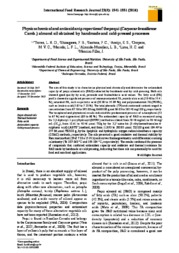Physicochemical and antioxidant properties of the pequi (Caryocar brasiliense Camb.) almond oil obtained by handmade and cold-pressed processes.
Physicochemical and antioxidant properties of the pequi (Caryocar brasiliense Camb.) almond oil obtained by handmade and cold-pressed processes.
Author(s): TORRES, L. R. O.; SHINAGAWA, F. B.; ARAÚJO, E. S.; OROPEZA, M. V. C.; MACEDO, L. F. L.; ALMEIDA-MURADIAN, L. B.; LIMA, H. C. de; MANCINI-FILHO, J.
Summary: Abstract: The aim of this study is to characterize physical and chemically and determine the antioxidant capacity of pequi almond oils (PAO) extracted by handmade and by cold-pressing. Both oils showed good quality by acid, peroxide and thiobarbituric acid values. The fatty acid (FA) profile showed a significant presence of monounsaturated FA, mainly oleic acid (53.48 to 55.41%); saturated FA, such as palmitic acid (33.30 to 35.89 %); and polyunsaturated FA (PUFA), such as linoleic acid (5.85 to 7.23%). The total phenolic (TP) and carotenoid content ranged in concentration from 87.56 to 392.00 mg GAE/100 g and 36.03 to 262.40 mg/100 g, respectively. The tocopherol and phytosterol results indicated the predominant presence of α-tocopherol (52 to 67%) and stigmasterol (63 to 68 %). The antioxidant capacity of PAO as measured using the 2,2-diphenyl-1-picrylhydrazyl (DPPH?) method oscillated from 58.48 mg/mL to 76.46 mg/mL (IC50), from 10.61 to 40.46 µmol TE/g by the 2,2′-azino-bis (3-ethylbenzothiazoline-6-sulphonic acid) (ABTS?+) method, and from 113.93 to 280.85 µmol TE/100 g and 164.49 to 277.86 µmol TE/100 g, by the lipophilic and hydrophilic oxygen radical absorbance capacity (ORAC) methods, respectively. The oils presented a good oxidative and thermal stability by Rancimat method (IP of 7.33 a 15.91 h) and curves thermogravimetric and differential scanning calorimetry (To 337-363 °C and 159-184 °C, respectively). The results confirmed the presence of compounds that conferred antioxidant capacity and oxidative and thermal resistance for PAO made by handmade or cold-pressing, indicating that these oils can potentially be used for food and non-food applications.
Publication year: 2016
Types of publication: Journal article
Unit: Embrapa Cerrados
Observation
Some of Embrapa's publications are published as ePub files. To read them, use or download one of the following free software options to your computer or mobile device. Android: Google Play Books; IOS: iBooks; Windows and Linux: Calibre.
Access other publications
Access the Agricultural Research Database (BDPA) to consult Embrapa's full library collection and records.
Visit Embrapa Bookstore to purchase books and other publications sold by Embrapa.

